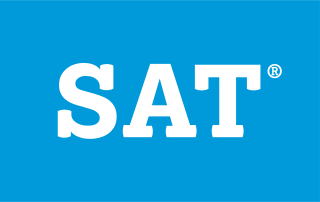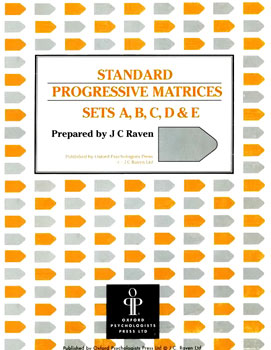Related Research Articles

The SAT is a standardized test widely used for college admissions in the United States. Since its debut in 1926, its name and scoring have changed several times. For much of its history, it was called the Scholastic Aptitude Test and had two components, Verbal and Mathematical, each of which was scored on a range from 200 to 800. Later it was called the Scholastic Assessment Test, then the SAT I: Reasoning Test, then the SAT Reasoning Test, then simply the SAT.

Mensa is the largest and oldest high-IQ society in the world. It is a non-profit organisation open to people who score at the 98th percentile or higher on a standardised, supervised IQ or other approved intelligence test. Mensa formally comprises national groups and the umbrella organisation Mensa International, with a registered office in Caythorpe, Lincolnshire, England, which is separate from the British Mensa office in Wolverhampton.

The Graduate Management Admission Test is a computer adaptive test (CAT) intended to assess certain analytical, quantitative, verbal, and data literacy skills for use in admission to a graduate management program, such as a Master of Business Administration (MBA) program. Answering the test questions requires reading comprehension, and mathematical skills such as arithmetic, and algebra. The Graduate Management Admission Council (GMAC) owns and operates the test, and states that the GMAT assesses critical thinking and problem-solving abilities while also addressing data analysis skills that it believes to be vital to real-world business and management success. It can be taken up to five times a year but no more than eight times total. Attempts must be at least 16 days apart.

The Graduate Record Examinations (GRE) is a standardized test that is part of the admissions process for many graduate schools in the United States and Canada and a few other countries. The GRE is owned and administered by Educational Testing Service (ETS). The test was established in 1936 by the Carnegie Foundation for the Advancement of Teaching.

The Law School Admission Test is a standardized test administered by the Law School Admission Council (LSAC) for prospective law school candidates. It is designed to assess reading comprehension and logical reasoning. The test is an integral part of the law school admission process in the United States, Canada, the University of Melbourne, Australia, and a growing number of other countries.
The Preliminary SAT/National Merit Scholarship Qualifying Test (PSAT/NMSQT) is a standardized test administered by the College Board and cosponsored by the National Merit Scholarship Corporation (NMSC) in the United States. In the 2018–2019 school year, 2.27 million high school sophomores and 1.74 million high school juniors took the PSAT. Scores from the PSAT/NMSQT are used to determine eligibility and qualification for the National Merit Scholarship Program.

The Prometheus Society is a high IQ society, similar to Mensa International, but much more restrictive. The entry criterion, achievable by a number of tests, is designed to be passable by 1 in 30,000 of the population, while Mensa entry is achievable by 1 in 50. The society produces a magazine, Gift of Fire, published ten times per year.
The Wechsler Adult Intelligence Scale (WAIS) is an IQ test designed to measure intelligence and cognitive ability in adults and older adolescents.

The Triple Nine Society (TNS) is an international high-IQ society for adults whose score on a standardized test demonstrates an IQ at or above the 99.9th percentile of the human population. The society recognizes scores from over 20 intelligence and academic aptitude tests. TNS was founded in 1978. Since 2010, it has been a non-profit 501(c)(7) organization incorporated in Virginia, USA. It is the second-largest high-IQ society after Mensa. As of February 2024, TNS reports a member base of over 1,900 adults in 50 countries.

Raven's Progressive Matrices or RPM is a non-verbal test typically used to measure general human intelligence and abstract reasoning and is regarded as a non-verbal estimate of fluid intelligence. It is one of the most common tests administered to both groups and individuals ranging from 5-year-olds to the elderly. It comprises 60 multiple choice questions, listed in order of increasing difficulty. This format is designed to measure the test taker's reasoning ability, the eductive ("meaning-making") component of Spearman's g.
Ronald K. Hoeflin is an American philosopher by profession, creator of the Mega and Titan intelligence tests. In 1988, Hoeflin won the American Philosophical Association's Rockefeller Prize for his article, "Theories of Truth: A Comprehensive Synthesis. His article argues for the interrelated nature of seven leading theories of truth.
A high-IQ society is an organization that limits its membership to people who have attained a specified score on an IQ test, usually in the top two percent of the population or above. These may also be referred to as genius societies. The largest and oldest such society is Mensa International, which was founded by Roland Berrill and Lancelot Ware in 1946.
The Wechsler Preschool and Primary Scale of Intelligence (WPPSI) is an intelligence test designed for children ages 2 years 6 months to 7 years 7 months developed by David Wechsler in 1967. It is a descendant of the earlier Wechsler Adult Intelligence Scale and the Wechsler Intelligence Scale for Children tests. Since its original publication the WPPSI has been revised three times in 1989, 2002, and 2012. The latest version, WPPSI–IV, published by Pearson Education, is a revision of the WPPSI-R and the WPPSI-III. It provides subtest and composite scores that represent intellectual functioning in verbal and performance cognitive domains, as well as providing a composite score that represents a child's general intellectual ability.
The Culture Fair Intelligence Test (CFIT) was created by Raymond Cattell in 1949 as an attempt to measure cognitive abilities devoid of sociocultural and environmental influences. Scholars have subsequently concluded that the attempt to construct measures of cognitive abilities devoid of the influences of experiential and cultural conditioning is a challenging one. Cattell proposed that general intelligence (g) comprises both fluid intelligence (Gf) and crystallized intelligence (Gc). Whereas Gf is biologically and constitutionally based, Gc is the actual level of a person's cognitive functioning, based on the augmentation of Gf through sociocultural and experiential learning.
The Otis–Lennon School Ability Test (OLSAT), published by the successor of Harcourt Assessment—Pearson Education, Inc., a subsidiary of Pearson PLC—is, according to the publisher, a test of abstract thinking and reasoning ability of children pre-K to 18. The Otis-Lennon is group-administered, multiple choice, taken with pencil and paper, measures verbal, quantitative, and spatial reasoning ability. The test yields verbal and nonverbal scores, from which a total score is derived, called a School Ability Index (SAI). The SAI is a normalized standard score with a mean of 100 and a standard deviation of 16. With the exception of pre-K, the test is administered in groups.
The Army General Classification Test (AGCT) has a long history that runs parallel with research and means for attempting the assessment of intelligence or other abilities.
The Cognitive Abilities Test (CogAT) is a group-administered K–12 assessment published by Riverside Insights and intended to estimate students' learned reasoning and problem solving abilities through a battery of verbal, quantitative, and nonverbal test items. The test purports to assess students' acquired reasoning abilities while also predicting achievement scores when administered with the co-normed Iowa Tests. The test was originally published in 1954 as the Lorge-Thorndike Intelligence Test, after the psychologists who authored the first version of it, Irving Lorge and Robert L. Thorndike. The CogAT is one of several tests used in the United States to help teachers or other school staff make student placement decisions for gifted education programs, and is accepted for admission to Intertel, a high IQ society for those who score at or above the 99th percentile on a test of intelligence.
The Naglieri Nonverbal Ability Test (NNAT) is a nonverbal measure of general ability designed by Jack A. Naglieri and published by Pearson Education. The Naglieri Nonverbal Ability Test - Individual Form was first published in 1998. Two versions were published in 2007 and 2008, respectively. This includes the group administered Naglieri Nonverbal Ability Test - Second Edition and the Naglieri Nonverbal Ability Test - Online version. The most current version is NNAT3. Like all nonverbal ability tests, the NNAT is intended to assess cognitive ability independently of linguistic and cultural background.
The Reynolds Intellectual Assessment Scales (RIAS) is an individually administered test of intelligence that includes a co-normed, supplemental measure of memory. It is appropriate for individuals ages 3–94.

Intertel is a high-IQ society founded in 1966 that is open to those who have scored at or above the 99th percentile, or the top one percent, on a standardized test of intelligence. It has been identified as one of the notable high-IQ societies established since the late 1960s with admissions requirements that are stricter and more exclusive than Mensa.
References
- ↑ "MAT Basics" (PDF). January 2021. Retrieved 2024-02-21.
- ↑ "How Much Does the Miller Analogies Cost?". Magoosh . March 1, 2016. Retrieved 2018-08-15.
- ↑ "About MAT (Miller Analogies Test)" . Retrieved 2023-05-22.
- ↑ "Taking the Miller Analogies Test: Registering at a Controlled Testing Center". Candidate Information Booklet 2011-2012. NCS Pearson. 2011.
- ↑ "Qualifying test scores". American Mensa. Retrieved 2021-03-15.
- ↑ "Intertel - Join us". www.intertel-iq.org. Retrieved 2021-03-15.
- ↑ "Tests & Test Scores - International Society for Philosophical Enquiry". www.thethousand.com. Retrieved 2021-03-15.
- ↑ "Join or Subscribe – The Prometheus Society" . Retrieved 2021-03-15.
- ↑ "MENSA qualifying test scores". Archived from the original on 2007-02-10.
- ↑ Kuncel, Nathan R.; hezlett, Sarah A.; Deniz S., Ones (2004). "Academic Performance, Career Potential, Creativity, and Job Performance: Can One Construct Predict Them All?" (PDF). Journal of Personality and Social Psychology. 86 (1): 148–161. doi:10.1037/0022-3514.86.1.148. PMID 14717633. Archived from the original (PDF) on 19 August 2014. Retrieved 19 February 2013.
- ↑ Kaplan, Robert M.; Saccuzzo, Dennis P. (2008-08-20). Psychological Testing: Principles, Applications, and Issues. ISBN 978-0495095552.